[ad_1]
Please check your local and national guidelines regarding the use of sand. It would appear that different countries within and beyond the UK may have different guidance in relation to Covid 19 and hygiene requirements .
Sandpits are one of the best features for stimulating creative play outside in a nursery or primary school. They provide hours of fun for children as they explore the properties of sand, experience the variation in the textures affected by the weather and seasons and develop the manipulative skills associated with pouring, digging, patting and adding water. Have a look at my Outdoor Sand Play Pinterest Board to get inspired about the possibilities. There’s now over 100 pins, most of which are my own photos and could be very useful if you are looking to change, improve or add sand into your outdoor space or school grounds.
Sandpits are commonplace in Australian school grounds and outdoor spaces. Now, given that Australia has its fair share of heat, flies, visiting animals and after-hours people and most other issues, I believe Australian educators, along their Scandinavian counterparts are setting a positive example for the rest of the world to follow. It seems that once a practice becomes part of the norm, part of just what happens in a school, then the less the issues are seen as issues.
So, below are some concerns that I commonly hear about sand in UK schools. The benefits of having sand available in schools and nurseries far outrank the effort needed to get a sand pit set up and maintained.
“Where we live, it’s too cold to play with sand in the winter…”
Put your sand inside a hut or create a den with sand inside. I’ve seen several of these in Scotland. It’s a nice way of providing shelter and makes an alternative to a standard play house. Below is a converted shed at Cowgate U5’s Centre.

Glendhu Childcare Centre in Launceston, Tasmania have a covered sandpit. The transparent ceiling and side panels means that lots of light shines through. It is immediately outside one of the doors to the outdoor space.
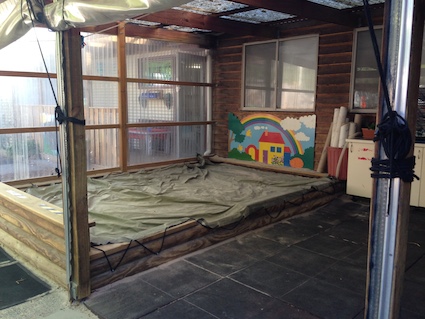
Children who visit beaches all year round, will tell you that it’s not too cold to play in sand in winter. The child in the photo below is digging into the sand at the end of November in Aberdeen, NE Scotland. When snow does lie on the beach, the textural comparisons are fascinating.
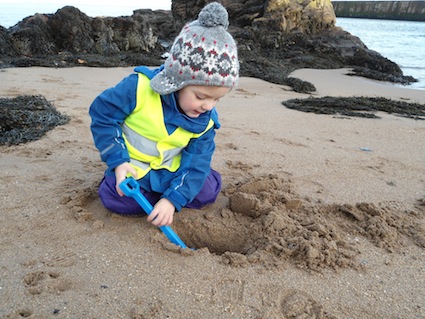
Ensuring children are adequately clothed for being outside on cold days is common sense. Have spare clothes available, e.g. from unclaimed Lost Property boxes for those who need it. In the UK it is extremely rare to have a day that’s too cold for sand play. I can’t remember one!
“It gets too hot to play with sand in the summer where we live.”
This is a sandpit in a pre-school in Melbourne (thanks Donna Ridley for letting me use her photo). It’s a small-scale approach to providing shade. Try and use material that will filter out uv light to avoid sunburn. Provide water nearby. Add ice cubes from the freezer and watch them melt into the sand.

The most effective shade is provided by trees. It is noticeably cooler in woodlands than open asphalt playgrounds. Include raking up leaves in your daily task list. Shade sails are a man-made alternative and I’m seeing lots around Australia. If you make your own then ensure the material does block out all the UV rays.
The sand pit featured above is at Clairvaux Catholic Primary School in Geelong. The school has a very sensible approach to sun and shade. During the summer months when the sun’s rays are at their strongest, the children must wear sun hats and protective clothing so they can play where they wish during break times. If a child arrives at school without the suitable clothing, then the child is expected to play in the areas, such as the sand pit, where shade is provided. They are certainly not kept inside!
“Imagine animal poop… ew!”
I feel this fear is over-rated. Generally cats and dogs don’t hang around school sandpits. Bird droppings may happen, as they will anywhere outside. However, if you have a visiting animal there are several precautions you can take. Putting a net or cover on the sand when not in use, works best.
If you have a bespoke sandpit which doesn’t have an easy shape to cover, then have a look at Teacher Tom‘s solution below (thanks to Tom for letting me use his photo). At his pre-school, the sand gets covered with burlap (hessian) bags donated from a local business.

The Jackman Avenue Public School grounds in Toronto is one huge sand pit. No cover is possible. I did ask if animals “doing their business” was a problem. It wasn’t. However, if you want to be sure, rake down the sand last thing at night and look for animal prints the next day.
Alternatively, consider the use of sonic repellents. These emit a high frequency sound beyond what human ears can hear but is an irritant for nearby animals. Be aware some children can hear the noise too, so switch off during hours of use.
“A sandpit needs a cover…”
No it doesn’t. Every sandpit needs to be properly looked after, cared for, managed and maintained. This may include a decision to put a cover on a sandpit. But there is no legal requirement in the UK for this to happen. Indeed, The Royal Society for the Prevention of Accidents states “If it is necessary to cover the sand an open cover made of, for example, a wire mesh is recommended to allow for natural cleansing and aeration.“
If you stop and think, such a requirement would be hard to enforce. There’s lots of parks and beaches where sand is not covered and where it would not be feasible. Also sand is used as a fall surface in playgrounds. Is this all just a cover up? (Pun intended).
Unfortunately for childcare settings in Scotland, Health Protection Scotland 2018 Infection Prevention and Control Guidelines for Childcare Settings cites the need for a cover for sandpits. This is a curious decision which I believe is unhelpful. See below for my reasons…
“Outdoor sandpits are unhygienic…”
Most countries and local authorities have strict guidelines that must be followed for the construction, management and maintenance of a sandpit. The Royal Society for Prevention of Accidents has this advice. Learning through Landscapes, the UK school grounds charity, has a couple of detailed advice sheet for schools covering a range of issues which have surfaced through their work with schools. You can download these from their website. This covers issues around finding dangerous litter, animal mess and so on.
The big issue is not sand in itself but that bacteria present in animal faeces can cause harm. So, ensuring that animals cannot access your sand pit is important. This involves active management as outlined in the RoSPA and Learning through Landscapes guidance. A sensible measure if you are permitted to have sand is to have hand washing facilities near to your sand pit. Children and adults can then wash their hands before and after sand play. This is in addition to the active management of the sand pit itself.
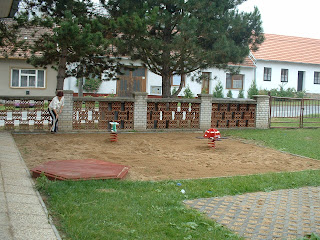
In my experience, the most unhygienic sandpits I see are ones that are covered up and not played with. The wet sand is left to stagnate. This is not okay. Sandpits need lots of natural light (a natural bleach), fresh air (added through being played in) and decent drainage (factor this into your construction)
“I hate flies on sand…”
Flies on sand? But there’s flies everywhere. Here in Scotland, when the wind goes down the midgies come out which give itchy bites. On hot days we get clegs which give big, nasty bites. If you live in a fly ridden place then take the protective measures you normally undertake, such as wearing insect repellant or mesh clothing. Experiment with aromatherapy oils to see whether citronella, tea tree or another scent moves insects on. If you have a real problem invest in a Mosquito Magnet or Midge Terminator.
“Sand stains my child’s clothing…”
Builder’s sand does contain a dye. White sand or silver sand is usually sold in DIY or toyshops and labelled for play. This should not stain. You can easily test this by rubbing a bit of wet sand onto a white cloth.
Be aware that lots of different sand is sold for different purposes. Sand that is used as a fall surface is different to builder’s sand. This is different to the sand found on golf courses. This differs to sand found in long jump pits, etc. So ensure you know what sand you need. Generally a mix of particle sizes is good from very fine to coarse but no bigger than 1.5mm. Do not remove sand from a beach and avoid crushed stone.
“My child comes home covered in sand…”
It is very hard to remove every grain of sand from a child. However, children from a very young age, e.g. 2 years old, can be taught how to remove their shoes or boots and tip out the sand. On cooler days children can wear all in one suits with elasticated cuffs that will reduce the amount of sand getting into clothes. If getting sand in hair is an issue – and it can be with braided hair – then one option is for the child to wear a hat or shower cap. On warm days, children can be taught to brush sand off themselves. Having a good strong brush available for this purpose is handy. It’s also a lot of fun for children to use the brush.

When the sand pit was installed at Inverallochy School, the head teacher worked with the parents to find a solution to this matter. The parents who do not wish their child to play in the sand pit are expected to have that discussion with their child and to trust them. The school does not police the children’s use of the sandpit as it simply isn’t viable with staffing levels.
“The sand gets everywhere…”
Whether children are at home or school, routines can be put in place to keep outdoor mess outdoors, such as learning to brush off the sand in the sand pit! This will minimise the impact indoors. Below – in the Swedish outdoor nursery, for 2 to 5 year olds, you can see the entrance into the indoor area. Children sit on the benches to remove their outdoor gear. They may not leave until all the clothes have been removed and footwear too. You can see the upright wooden boot remover! These routines really encourage independence.
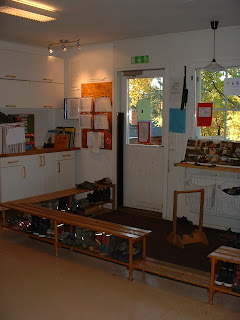
Thinking about the construction of a sandpit can also help reduce the amount of sand dispersal. The wooden decking around the Inverallochy sand pit makes a big difference here.
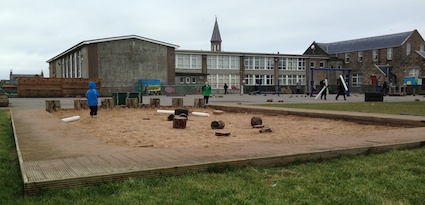
Another option is to put a sand pit in a sheltered spot or corner where wind blown sand is reduced. In the photo below, this sand pit is informal. It’s been developed through years of sand being moved from a nearby school sandpit. It’s a quieter and gives a group of children more peace to play.
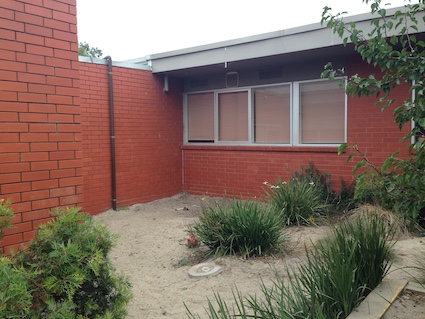
Wind-blow can also be reduced through screening with plants and trees.
“You can’t move a sand pit about…”
Oh yes you can! Here is a temporary sandpit on blue tarp, with a few planks around the end. If you are not sure where to site a sandpit then this is one way of experimenting to find the best place. Furthermore, it can be wheelchair accessible and babies can easily crawl onto it.
I loved this miniature sand pit that I saw at Ladybird’s Parent and Toddler group. To have the sand in a wheelbarrow means that it can be easily transported. Once levels get low, the wheelbarrow can be moved out of the woods, filled up with sand and trundled back again. Very clever! A tuff spot is used to cover the sand – mainly owing to leaf fall in the woods. Look how well it has been dug into the ground in order to keep it stable.
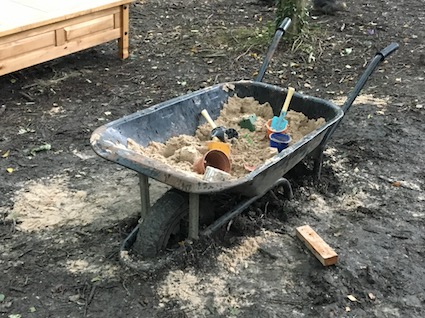
Another option is the use of tyres to create temporary sandpits. Do be aware that these do not stay pristine for long. Sand will be displaced. So plan for the mess around the edges and systems to manage this, if needed.
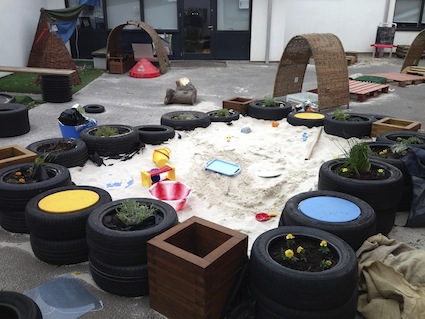
“Sandpits are not accessible by children who can’t walk or who are in wheelchairs…”
With a little bit of creativity they can be. Below, the sandpit is for 1 and 2 yr old children in an outdoor nursery in Sweden where the children have year round access in all weathers. The ramp is there for the children to crawl up.

Depending on the individual needs of each child, sand can be provided at a table outside. Long handled tools, buckets on string and other props can be used for children to access sand. Some children enjoy sitting, rolling around, lying in sand and even being buried. Ask and discuss with each child, building upon their ideas, suggestions and reactions to sand.
Above is a sand table designed for wheelchair users who can’t leave their seats. It came highly recommended from a friend who works at a Camphill School. Below is a public sandpit (note no cover and the smooth raking) which provides a gentle ramp for buggies, etc.

I also saw a beautifully designed inclusive public play space for children. In Perth, the Nature Play Solutions Landscape Architect, the late Wendy Seymour, ensured the sand feature can be accessed at wheelchair height at the Theatre Gardens Playspace. Also, beside the sand is a “shuffle-along” seat. Anyone can sit there, but a child with mobility issues can move themselves down into the ground level sand, should they wish to do so.
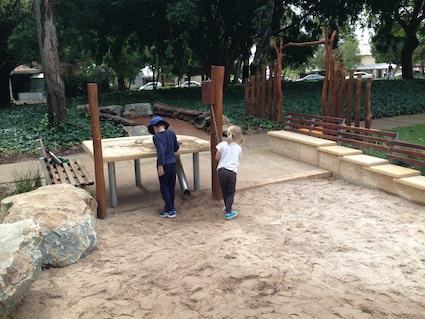
How much sand do we need to buy?
Typically sand comes in 25kg or you can bulk buy from gravel merchants. Most sand sellers are cagey about quantities needed. They reference their own bags in their sand calculators without referring to metric or imperial units. However this company.
At Upper Sturt Primary School, the children created a sandpit as part of a classroom project. They drastically overestimated the quantity so the school created a second sand pit!
How do we ensure our use of sand is sustainable?
As much as possible buy from sand from a local supplier or quarry. Some topping up of sand is needed from time to time but this can be reduced by:
- Reducing wind blow! You may need a corner, to add bushes near by or erect a permeable fence which reduces the windspeed but still allows wind to move through it. Impenetrable barriers create eddies around the sides and above so don’t always work.
- Putting in place routines that support children to brush off sand in the sandpit in an entrance/exit point.
- Adding a cover overnight.
………………………………………………………………………….
Finally, if you have EVER blogged about sandpits and children playing in sand, please leave a link to your posts in the comments section. Thank you very very much. Also the first photo comes from a lovely nursery, Milford Lodge, up on the Sunshine Coast in Queensland. Furthermore please let me know if there’s other information that you would find helpful.
This is an updated version of a post which originally appeared in July 2010.
Related
[ad_2]
Source link


More Stories
Transforming Appearances with the Perfect Hairpiece Touch
Exploring the Wonders of Modern Sciences
How Sciences Unlock the Mysteries of the Universe